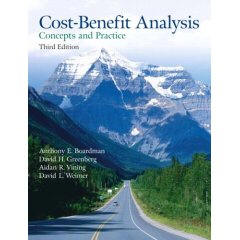
ECO 3660. Benefit-Cost Analysis
Fall 2007 | Calendar
TR 9:30-10:45, Raley Hall 1012
Instructor: John Whitehead
Office: Raley Hall 3094
Office Hours: MW 9-11, 2-4; appointment, open door
Phone: 262-6121 (office), 262-2148 (department), 773-5049 (cell)
Fax: 262-6105
e-mail: [email protected]
URL: http://www.appstate.edu/~whiteheadjc/ECO3660/Fall07
Last Update:
11/29/2007
Catalog Description
The study of the evaluation of competing public policy alternatives. The
purpose of benefit-cost analysis is to inform government decision-making and
facilitate the more efficient allocation of scarce resources. This course
introduces the basic theory and principles of benefit-cost analysis and examines
applications of the methodology. Prerequisite: ECO 2030.
 Textbook and Reading Assignments
Textbook and Reading Assignments
Cost-Benefit Analysis, 4e,
Boardman, Greenberg, Vining and Weimer
Course Outline / Reading Assignments
- Introduction (Chapter 1, pp.
1-17)
- Conceptual Foundations (Chapter
2, pp.
26-33, 35-39, 41-46)
- Microeconomic Foundations
(Chapter 3, pp. 51-61)
- Primary Markets (Chapter
4, pp.
73-98, 103-106)
- Secondary Markets (Chapter
5, pp.
112-120)
- Discounting (Chapter
6, pp.
131-140, 145, 146-151), (Chapter 10, pp.
236-238, 247-253, 245-246, 258-261)
- Dealing with Uncertainty (Chapter 7 pp.
165-171, 175-184)
- Valuing Impacts from Observed Behavior: Demonstrations
(Chapter 11, pp. 279-285)
- Valuing Impacts from Observed Behavior: Direct
Estimation of Demand Curves (Chapter 12, pp.
314-329, Appendix)
- Valuing Impacts from Observed Behavior: Other Revealed
Preference Methods
- Existence Value, Contingent Valuation: Using Surveys to Elicit
Information About Costs and Benefits
- Shadow Prices from Secondary Sources
- How Accurate is CBA?
Recommended Reading
- Dumas, Schuhmann and Whitehead, AFS Symposium, 2005 [PDF].
- Graham, REEP, 2007 [PDF].
- Hahn, Journal of Economic Perspectives, 1998 [PDF].
- Hahn and Dudley, REEP, 2007 [PDF].
- Rose, et al., Natural Hazards Review, 2007 [PDF].
- OMB, Draft 2007 Report to Congress on the Costs and
Benefits of Federal Regulations [PDF].
Grades
The grades are based on the homework assignments (worth 100 points each) and
two
exams (worth 100 points each). The maximum number of points is 300. Final grades will be
assigned as follows:
| Grade |
A |
A- |
B+ |
B |
B- |
C+ |
C |
C- |
D+ |
D |
D- |
F |
| % |
93.33 |
90 |
86.67 |
83.33 |
80 |
76.67 |
73.33 |
70 |
66.67 |
63.33 |
60 |
below 60 |
| Points |
280 |
270 |
260 |
250 |
240 |
230 |
220 |
210 |
200 |
190 |
180 |
below 180 |
Exams
There are two exams during the semester -- one in-class mid-term exam and a final
exam administered during the final exam period. Each exam is worth 100 points. A
university excused
or emergency absence is usually
necessary to schedule a make-up exam. Each exam is graded on a 100 point scale.
Homework Assignments
There are a number of homework assignments during the semester worth 100
points. These will generally involve questions at the back of the textbook
chapters.
Miscellaneous
Class Attendance: From the catalogue: "It is the policy of Appalachian State University that
class attendance is considered to be an important part of a student's
educational experience. Students are expected to attend every meeting of their
classes, and are responsible for class attendance."
Classroom behavior: The following classroom behaviors are not acceptable: excessive and/or
loud
chatting with other students, disruptive coming and going, answering your
cell phone and other annoying behaviors.
Academic Dishonesty: It is the responsibility of every
student to abide by the Appalachian State University
Academic Integrity Code. In short:
"Students will not lie, cheat, or steal to gain
academic advantage."
Disabilty: "If you have a disability for which you are or may be
requesting an accommodation, you are encouraged to contact both your instructor
and the Office of Disability Services,
222 D.D. Dougherty, 262-3053/262-3056 (TTY) as early as possible in the term."
ASU Office Hours Policy: Every full-time faculty member is required to
be available seven (7) hours per week during the regular academic year to
consult with students. Requirements for part-time faculty will be prorated
according to the number of hours taught. Each department will maintain an office
hours policy that establishes standards regarding a mix among formal office
hours, meetings in other locations, and electronic communications appropriate
for faculty members and curricula in that department. A schedule indicating the
times available for formal office hours, meetings in other locations, and
electronic communications must be posted on the faculty member�s office door,
listed on course syllabi, and provided to the departmental office at the
beginning of each semester. Electronic communication addresses, URLs, and/or
phone numbers must be listed on course syllabi and also provided to the faculty
member�s departmental office. During the term of a summer session in which a
faculty member teaches, office hours expectations are half of those during the
regular academic year.
Last Update:
11/29/2007
 Textbook and Reading Assignments
Textbook and Reading Assignments